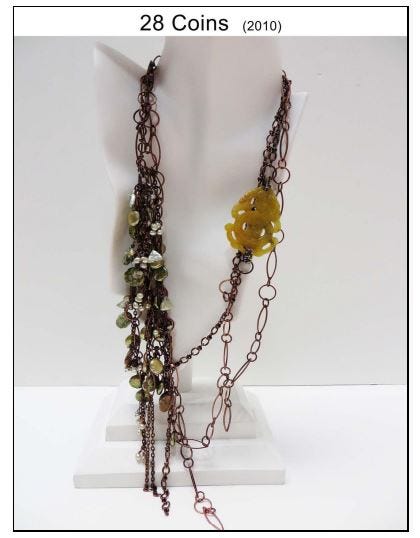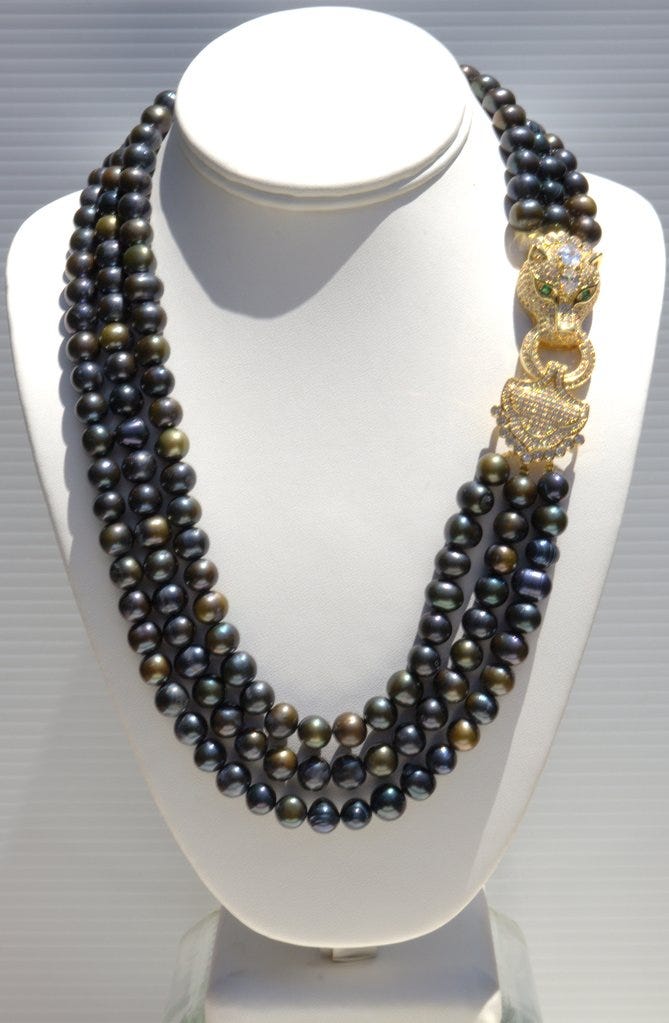HOW DOES THE JEWELRY DESIGNER MAKE “ASYMMETRY” WORK ?
Posted by learntobead on June 28, 2020

One Principle of Jewelry Design Composition is called “PLANAR RELATIONSHIPS”. This primarily has to do with the placement of lines and planar surfaces within your piece, and how satisfying all this placement is, so that the lines and/or planes interrelate.
It turns out it is relatively easy to have lines and planes relate symmetrically. That is, it is easy to get people to be more satisfied with your pieces, if you makes things line up evenly to the right and to the left of your center point or line.
Conversely, it is not so easy when you try to create something asymmetrical. In fact, based on the art theory and cognitive psychology theory underlying this principle of planar relationships, I would say that, if your piece is asymmetrical, there must be something else on the person wearing the piece to create the illusion of symmetry. This might be the way the hair is styled, the pattern on a dress, the neckline silhouette of the dress, the shape and positioning of the person’s ears, and the like.
So, for those of you who have tried and succeeded, or tried and failed, to create asymmetrical pieces, how would you describe your design process? And people’s reactions to your piece? Or how it looked on the wearer? If successful, what kinds of things did you do in the design process, that worked in your favor?
Off-centered piece or someone wearing just one earring, can be disorienting and disturbing. How do you feel about asymmetrical pieces, or people wearing only one earring?
PLANAR RELATIONSHIPS
Planar Relationships refers to the degree the piece is not disorienting to the viewer, or particularly confusing in terms of what is up and what is down, or what is left and what is right.
People always need to orient themselves to their surroundings, so that they know what is up and what is down. They usually do this by recognizing the horizontal planes of the floor and the ceiling of a room (ground and sky outside), and the vertical planes of the walls of a room (buildings, trees and the like outside).
Jewelry must assist, or at least not get in the way of, this natural orienting process. It accomplishes this in how its “lines” are arranged and organized. If a piece is very 3-dimensional, then how its “planes” are arranged and organized becomes important, as well.
The goal here is to “see” the piece of jewelry, especially when worn, as something that is coherent, organized, controlled, and, especially, orienting.
Design elements we might use to achieve a satisfactory planar relationship within our piece:
— a strategic use of lines and planes
— shapes
— boundaries
— silhouettes
— contours
— symmetry, or, more difficult to achieve, a satisfying asymmetry
— a planar pattern in how each section of the piece relates to the other sections
— how sections of the piece interlock
— how we “draw and interrelate” parallel lines, perpendicular lines and curved lines within the piece
Example 1: Asymmetric Earrings

How can a person truly pull off wearing only one earring, or two very different earrings, one on each ear? After all, visually, it pulls the person off to one side, thus violating the basic orienting planar relationships. What about the composition of the earring, allows this to work; what about the composition doesn’t?
Example 2: Asymmetric Necklace

When wearing a necklace, where the clasp is worn on the side, instead of the back, sometimes this works, and sometimes it does not. Again, what about the composition of the necklace, allows this to work; what about the composition doesn’t?
With jewelry, asymmetry is a trend the pops up everyso often. In theory, it feels new, different, cool. It allows the wearer to assert a level of individuality and spirit. In practice, it can be awkward, but can be pulled off. As designers, when we want to achieve asymmetry, we have to fight off the brain’s natural tendency to want harmony and balance, thus symmetry.
The easiest way to achieve this is to use other environmental clues — hair styles, clothing styles, patterns in fabric — to assist. We can also play with things like volume, mass and color proportions, where both sides of a piece are visually different, but equal in either total volume, total mass or total color proportions, as if the piece of jewelry were a surrogate balance scale.
Other Articles of Interest by Warren Feld:
Best Way To Thread Your Needle
Bead Stringing With Needle and Thread
Turning Silver and Copper Metals Black: Some Oxidizing Techniques
Color Blending; A Management Approach
Cleaning Sterling Silver Jewelry: What Works!
What Glue Should I Use When Making Jewelry?
When Choosing Colors Has You Down, Check Out The Magic Of Simultaneity Effects
When Your Cord Doesn’t Come With A Needle…What You Can Do
What To Know About Gluing Rhinestones
Know Your Anatomy Of A Necklace
How Does The Jewelry Designer Make Asymmetry Work?
How To Design An Ugly Necklace: The Ultimate Designer Challenge
I hope you found this article useful. Be sure to click the CLAP HANDS icon at the bottom of this article.
Also, check out my website (www.warrenfeldjewelry.com).
Subscribe to my Learn To Bead blog (https://blog.landofodds.com).
Visit Land of Odds online (https://www.landofodds.com)for all your jewelry making supplies.
Enroll in my jewelry design and business of craft video tutorials online.
Add your name to my email list.








Leave a comment